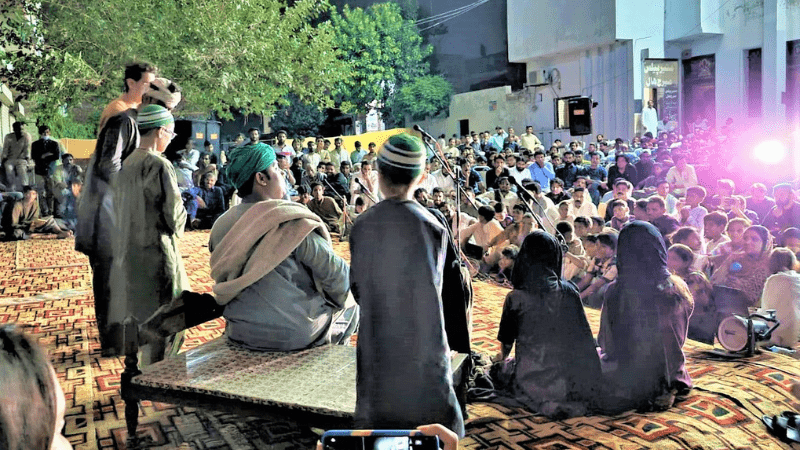For 12th year, Lahore’s Sangat performs Punjabi street play at Bulleh Shah mela

Every year, Punjabi theatre lovers are among the many people who gather in Punjab’s Kasur to honour 17th century Sufi poet Bulleh Shah at his shrine. The three-day urs (death anniversary of a Sufi saint) includes an annual theatrical performance and this year, which marked the 265th anniversary of his death, a play called Konan Kon Sunja Tey (The Identity-less Connect with the Identity-less) was performed.
Renowned Punjabi street theatre and cultural artist Huma Safdar has been taking her Lahore theatre troupe, Sangat, and singing team to Kasur for the last 12 years and this year was no different. On their way to pay tribute to the great poet, they hurried to make it in time for the 60-minute performance. The local host, from organisation Sanjha Vehra, in turn, gathered theatre lovers from surrounding districts to join the audience.

Konan Kon Sunja Tey is directed by Safdar and written by Najam Hussain Syed. Involving a great deal of dance and music, the play is about Nizam Lohar and his band that challenged British colonial authorities in the pre-Partition era. The British declared him a dacoit but he is popularly referred to by the Punjabi word dakoo. Lohar was killed in an encounter with the British after being cheated by a friend who conspired with the colonial settlers. He shared his friend’s whereabouts to acquire the bounty on his head.
The play is inspired by the Punjabi tradition of dholas — a form of storytelling where people’s heroes are built, historical facts and memories around them are gathered and knitted in a popular poetic way. Most of the dholas are part of the oral history of Punjab. This kind of work is done by Harappa-based writer AD Ijaz who collected dholas, sung and remembered Ahmed Khan Kharral who was killed in September 1857 by the British for leading a public revolt in Neeli and Sandal Bar. Within 48 hours, local rebels of Neeli and Sandal Bar took revenge by murdering Lord Berkeley on the left side of the Ravi River.

Ijaz is the first person in Punjab to collect war stories after 15 years worth of effort, capturing the heroic struggle of Kharral. His book Kall Bulandi Aya was published by the Punjabi Adabi Board in the 80s and is considered a pioneering document in Punjabi oral tradition.
The play’s writer, in the same manner, wrote about the 20th century Punjabi poet Noori Kemoke whose poem Noori Di Boli, was regarded as one of the most critical works in Punjabi literature. In one of the narrations in his book Ahiyain Vechoun Nahiyain, Syed quoted Noori Kemoke’s dholas about Nizam Lohar from the early 19th century and connected it to the resistance of the people of the Bar who had gone wild around the cities of Lahore, Amritsar and Kasur during colonial times:
“Thus the ever-echoing voice spoke,
Nizam heard the voice and roared.
Lenders kneeled before the colonial occupants,
seeking protection from Nizam Lohar.
Nizam declares his resolve to rob capitalists, hoarders and goldsmiths.
Nizam draws a line and stands;
he empowers peasants, workers and destitute hands.“
‘Kaal’ is the feminine voice of a dhola’s narrator. It symbolises the accumulated pain of the century-old history of oppression. However, in Konan Kon Sunja Tey, writer Syed goes beyond the dholas and expands the story with a wider angle of sensitivity where the women’s contribution to the resistance is considered. The writer developed and shaped characters, giving them deeper engagement with the question of freedom. He also handled religious biases in the play sensitively and brought forth the major contradictions of that period.
The performance team consisted of Sangat’s experienced female cast and volunteers from fresh graduates courses of Agricultural University, Faisalabad. Nazir Joya, president of Sanjha Vehra, arranged the play. He told Images the production was experimental for the local audience and fun for people used to theatre plays. “Because they know Sangat and the team as their neighbours, friends and comrades,” he explained. Both Sangat and Sanjha Vehra believe in non-commercial peoples’ creative initiatives and collaboration.
According to Joya, more than 1,200 people — children, women, students from public schools, Punjabi intellectuals from other cities and the general public — were invited to watch the street play. Many families watched from their balconies too.
Members of the audience also enjoyed it. Alyas Ghuman, who came from Gujranwala, told Images that this is not commercial theatre — but theatre with purpose. He called the colours, live music, and performance by the actors “marvellous”.
Riaz Ahmed, a resident of Rohi Nala, commended the performance and the actors (who are students and part-time workers), saying they acted perfectly, “like mature actors”.
Naheed Bibi, resident of Joya Market, said the performers were perfectly in sync with their roles as well as with the audience. “It’s not theatre but rather a dialogue between the audience, musicians and actors,” she added.